Network configuration, Adding a network – Daktronics Venus 1500 Ver 3.x User Manual
Page 20

The Venus 1500 Administrator
6
A network consists of multiple displays connected to each other. Up to 240 Venus 1500-
controlled displays can exist on one network.
When
is selected, a network may be configured for communicating with
displays. The Network Configuration screen provides the tools to add a network, edit an
existing network, or remove a network. Refer to Section 3.1 Display Creation Wizard for the
recommended way of configuring a network.
Note: Manual Display Creation is an alternative to using the Display Wizard to
configure networks. Instructions for this process are available in Tutorial 2: How to
Configure a Network Manually.
Three different types of networks exist and are explained in the following list:
Direct Network indicates that a serial connection exists between the PC and the
display(s).
Dial-up Network indicates that an analog modem is used to communicate with the
display.
TCP/IP Network indicates a connection across a network using the TCP/IP protocol.
TCP/IP must be installed and correctly configured for the computer that has the
Venus 1500 software installed. All serial server or display addresses must be
static or use a fully qualified DNS name. Contact your system administrator to
obtain a static IP address or DNS name.
In some instances, a TCP/IP connection requires a serial server device connected
to an Ethernet network for communication to displays. The TCP/IP Address is
the address of the serial server on the Ethernet network. For a Lantronix
™
serial
server, the TCP/IP Address is the address that was applied to the device when it
was configured. If a Lantronix serial server is being used, refer to Daktronics
manual ED-9623 for MSS-1 or MSS-100 and ED-12850 for the UDS-1100
instructions on configuring the serial server and assigning a static IP address. The
IP address of the serial server must be set in the TCP/IP network in the Venus
1500 software.
Refer to Tutorial 5 for instructions on adding, editing, and deleting networks.
